
|   |

|   |
An ambitious ode to Astras - Veejay Sai e-mail: vs.veejaysai@gmail.com Photos: Sanjay Koul September 21, 2016 While putting together thematic festivals on dance has become a trend now, not all of them are invigorating enough in their conceptualization and content. If the content is smartly drawn out, the dancer ends up putting together a shoddy hotchpotch and when the dancer is brilliant, the theme remains sterile. But in the recent past, thanks to a few thinking curators and festival programmers, Bharatanatyam or for that matter several other classical dance forms have benefitted with some high quality work on display. ‘Divya Trilogy’ is conceptualized by arts curator and impresario Usha Rk. In the past we have seen how she has come up with highly innovative themes and created newer content for classical dance. Be it a festival dealing with the composition of poet saints like Bhadrachala Ramadas or with literary themes like Sanskrit poetry, she has successfully conducted several festivals in Bangalore, Bombay and elsewhere. After migrating to Delhi to work as the Member Secretary of the Intangible Cultural Heritage project undertaken by the Ministry of Culture, she kept her passion for dance alive in Delhi as well. The current project ‘Divya Trilogy’ is a rather ambitious one. The first of these three festivals ‘Divya Astras’ was conducted to a packed Stein Auditorium at the India Habitat Center on September 15, 2016. She ideated these festivals inspired by the writings of Shri Aurobindo and The Mother on one of her trips to Rishikesh and Haridwar, she announced at the beginning of the evening. Presenting five dancers in five solos, the evening began with a solo by Himanshu Srivastava. A student of Guru Saroja Vaidyanathan, Himanshu performed the ‘Brahma Astra.’ It was a refreshing start to see the good old Brahma Sandhi Kauthuvam being revisited. He showed the four faces of Brahma and how each of the four seminal Vedas emanated from them. After establishing the Astra, he took on the role of a Katha vachak or a traditional storyteller and went on to narrate the incident from the Ramayana where the Brahma Astra was used. The duet singing of nattuvanar Vasudevan Iyengar and Satish Venkatesh enhanced the mood of his performance. With clean nritta and abhinaya that was just enough for the choreography, Himanshu’s performance was a pleasant start to the evening. For a north Indian boy who does not speak a single south Indian language, his mastery over this dance is commendable. Kudos to his guru Saroja Vaidyanathan who worked tirelessly to bring him to this state of perfection. 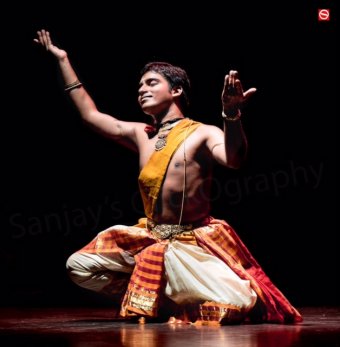 Himanshu Srivastava 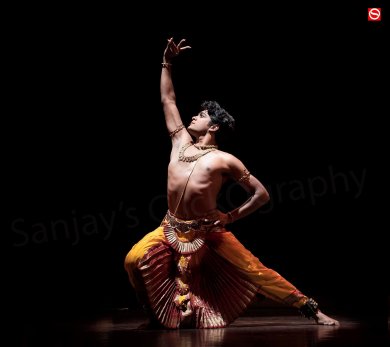 Mithun Shyam The next Astra was the ‘Sudarshana Chakra’ of lord Vishnu. The Sudarshana is prayed to since ancient times. As the famous ‘Chakrathalwar’ in the Vaishnava tradition, the discus of lord Vishnu has fascinating stories surrounding it. Mithun Shyam from Bangalore performed his solo to this theme. Set to ragam Chakravakam, Mithun’s utilization of the Pataka hasta, circular movements akin to martial art motifs to depict the discus was smart choreography. He narrated three instances where Sudarshana was important to the myth. First was the killing of Jayadratta in the Mahabharata. Those of you who know your Mahabharata don’t need a retelling here. The usage of Mithun’s hands to show Krishna sending the Sudarshana to cover the sun and create an illusion of dusk was innovative. The second episode was the slaying of Shishupala by Krishna. The third was an episode from the Devi Bhagawatam after the Dasksha Yagna. Seeing a tormented Shiva carrying the body of Sati, Vishnu sends the Sudarshana to sever the body into pieces. This gives birth to the famous Shakti Peethas that are worshipped till date. With some dramatic elements in his performance, set to ragams like Shanmukhapriya, Mithun displayed his creativity over the topic. Fresh in his choreography and with clean lines in his nritta, Mithun displayed his maturity in handling the subject. He also outdid himself by putting up a good show unlike never before. Stitched and fitted costumes with several fans hanging don’t suit a male body as much as a good old drape with a back piece does. The current stitched costume was also covering his footwork in places. Mithun is certainly among our best dancers and the credit must go to his guru, the late Padmini Ramachandran who gave us several good soloists. If he continues on this note, he is bound to go places. 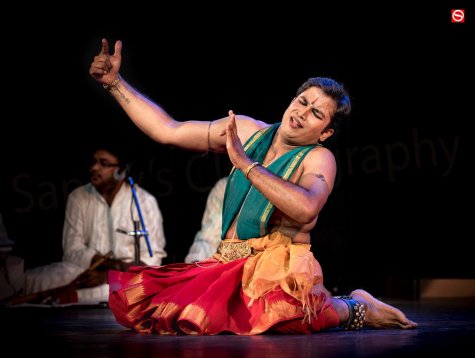 Anil Iyer The third Astra was the ‘Pushpa Astra’ or the famous arrows of Manmatha. Performed by Anil Iyer from Bangalore, it was a change in the mood for that evening. Set to a slow paced Vasanta ragam, we see Manmatha playing around in sugarcane fields before he makes a bow out of a cane stringing it with a row of bees. Depicting the five flower arrows Manmatha attacks Rathi with, Anil detailed each of them. The Aravinda flower that causes Unmaadanam, Ashoka flower that causes Taapanam, Chootapushpa that causes Soshanam, Nava Mallika flower that causes Sthambanam and Nilotpala flower that causes Sammohanam. These are states of mind and body that are caused as an effect of these flowers. Using different ragas to show the transition, Anil designed his choreography smartly. Though not as fit and in shape like earlier, Anil, who is pursuing a different career, hasn’t forgotten his dance training under Guru Purnima Gururaj of Bangalore. The fourth was the ‘Pinaka Astra’ performed by Parshwanath Upadhye from Bangalore. Parshwanath brought about a different energy to the stage even as he entered. Beginning with the construction and establishing of the Astra he depicted how mother earth took the form of a chariot with the sun and moon as wheels and Brahma the charioteer. Holding the mount Meru as his bow, the snake god Vasuki as the string, Vishnu as an arrow that has fire god Agni in the front and Vayu at the tail end, Shiva destroys Tripura with the Pinaka Astra. The story of how the Astra was presented to Parashurama and further enshrined in the court of king Janaka of Mithila connected the narrative to a significant episode in the Ramayana. Showing the might of the Astra as it is put on a pedestal in Janaka’s palace, we saw courtiers struggle to shift it inch by inch. And then came the daughter of Janaka who while playing with her friends found her flower ball rolling under this pedestal. She casually lifts the bow and takes her toy and continues even as an amazed Janaka sees this whole incident. From there on, to the Swayamwara of Rama where he has to string the bow to win over other princes. The narrative ends with the dancer himself showing his body as the bow. The choreography was smooth throughout. Added to this was Parshwanath’s lightning speed nritta. Having studied from gurus Kiran Subramanyam and Sandhya Kiran, Parshwanath is a master of taalam. He was the superstar among the male dancers that evening. There wasn’t a single person in the audience who didn’t go back raving about his performance. This proud son of Bangalore is easily one of our country’s top young male Bharatanatyam soloists. 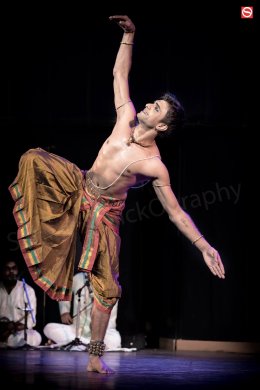 Parshwanath Upadhye 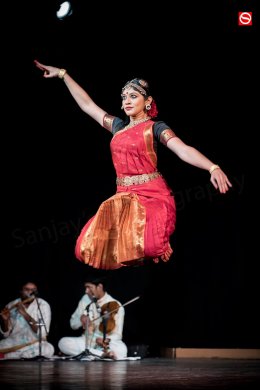 Dakshina Vaidyanathan
The last Astra was the famous ‘Trishula.’ Not the Trishula of Shiva but the one of mother goddess Durga. Dakshina Vaidyanathan, one of Delhi’s best young female soloists, was the Shoola Dhaarini Devi. Dakshina began with the famous sloka depicting the hastas as she decorated the Devi before she established the Trishula. The first part of her presentation was the story of Devi killing Mahishasura with her Trishula. Without too much elongation and drama, Dakshina concluded the act. The second half set to ragam Charukesi gave a refreshing new interpretation of the Trishula in dance. Sourcing material from Thirumular’s treatise ‘Thirumanjanam’, Dakshina depicted the esoteric side of the Astra. The three spokes being the Ida, Pingala and Sushumna Naadis, the Trishula then morphs into an instrument that awakens the Kundalini. Dakshina’s choreography added to her perfectly arresting theermanams and subtle abhinayam made the segment enjoyable. With an enviable stage presence and dancing skills, Dakshina is an asset to Delhi’s otherwise somber Bharatanatyam scene. One of the strong points of this festival was the brilliant orchestra. With nattuvangam by Vasudevan Iyengar, mridangam by R Keshavan, Raghavendra Prasad on violin and Rajat Prasanna on flute, Satish Venkatesh’s melodious voice rang through the hall tirelessly for all the five solo performances. It was also a well-timed program with no unnecessary clutter like calling in politicians to light lamps or giving long speeches. The packed hall was enthralled by some of our finest young thinking and hard-working dancers. Kudos to Usha Rk not just for thinking up this brilliantly fresh theme but also executing it with a great deal of professionalism. The next two in the trilogy are ‘Divya Vahana’ and ‘Divya Pushpa’ being held in November and December. Veejay Sai is a writer, editor and a culture critic. |